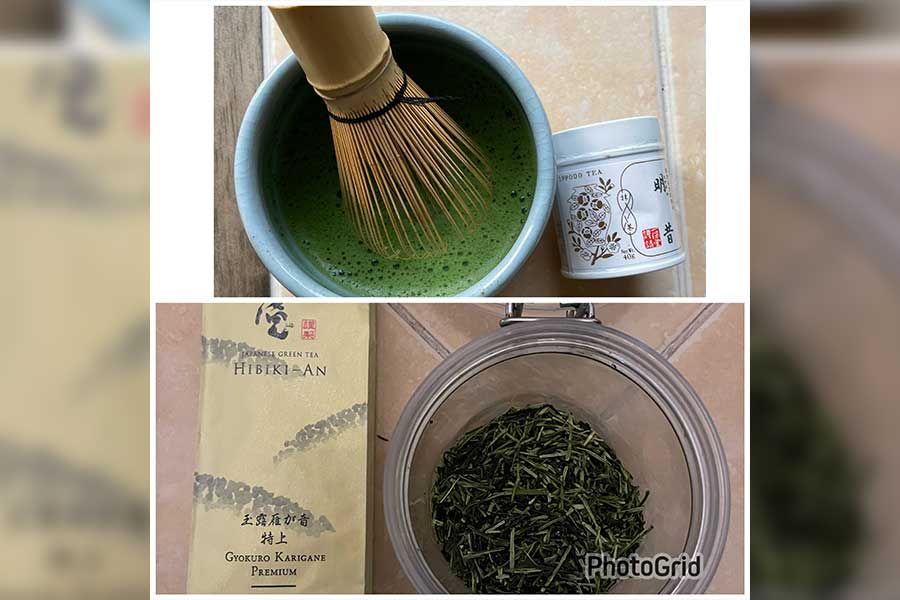
I start my day with a morning cup of Karigane (stems of shaded green tea) about an hour after waking up. It has less caffeine and a pleasant, slightly sweet taste—a perfect first drink for the morning. My main caffeine hit comes in at 10:30 AM, usually in the form of a bowl of ceremonial-grade matcha or a 60-ml shot of umami-filled Gyokuro. Both of these are high in caffeine and the amino acid L-theanine, resulting in a focused yet relaxing experience.
In the late afternoons, I enjoy a cup of Hojicha (roasted green tea) with almost zero caffeine and a smooth, mellow taste. This green-tea-centered setup, as of September 2024, gives me consistent energy throughout the day—a mix of caffeine and the ADHD miracle compound, L-theanine. Besides these, I occasionally consume Sencha, Kukicha, Mugicha, and Konacha.
If you haven’t heard of these teas, it’s because they’re not commonly consumed outside of Japan and are not heavily marketed. Sencha is the most common green tea in Japan, and interestingly, most Japanese do not consume matcha, much like most Indians don’t practice yoga.
Before switching to Japanese green tea, I was an avid coffee drinker with an elaborate setup—espresso makers, grinders, tools, and a temperature-controlled kettle with a gooseneck. Before becoming a coffee connoisseur, I endured bad instant coffee, terrible Nespresso pods, and overpriced Starbucks drinks. My pursuit of better taste led me to explore freshly roasted and high-quality beans. Ethiopian Yirgacheffe for a fruity floral taste, Brazilian beans for a nutty chocolaty flavor, and Panama Geisha for a champagne-like coffee experience. Yemen coffee deserves its own blog—it’s exquisite! My journey into the world of specialty coffee became a full-blown hobby.
So why did I switch from coffee to specialty coffee, only to later abandon coffee altogether for green tea? The answer lies in my ADHD brain, specifically its novelty-seeking behavior. People with ADHD are drawn to new experiences. Novelty stimulates our brain, allowing us to thrive in new environments and during periods of learning. Novelty is to ADHD what fuel is to a fire—it ignites interest and motivation.
I was diagnosed with ADHD at age 14 and again at age 32. ADHD, or Attention Deficit Hyperactivity Disorder, places me in the category of ‘neurodivergent’ as opposed to ‘neurotypical’ brains. For simplicity, I refer to ADHD brains as “Pendulums” and regular ones as “Normies.”
The opposite of novelty for us is routine—doing the same thing repeatedly. While Normies might strive for balance in their work-life routine, Pendulums crave change. Rediscovering my ADHD in my early 30s has helped me understand how it has shaped my past.
Novel experiences release dopamine, which makes it easier for Pendulums to focus on new and exciting tasks. Since ADHD brains naturally have lower dopamine levels, we go to great lengths to chase it. When intensity, novelty, and focus align, Pendulums can learn remarkably fast.
Although my green tea journey began humbly with Lipton teabags, I eventually found its most supercharged versions in Japan. Like my deep dive into specialty coffee, I uncovered layers of fascination in green tea, which has kept my novelty-seeking mind engaged. The Japanese essentially weaponized green tea, modifying how they grow and process it, transforming a simple drink into something complex and exciting.
This same drive for novelty, which allows Pendulums to focus intensely on new experiences, makes sticking to a repetitive routine difficult, even when it’s necessary for long-term success. Over the years, I’ve developed coping mechanisms. Since I can’t overhaul my entire routine—especially in career and relationships—I experiment with small pockets of my day, like my caffeine habits, that lie outside the main work zone and family zone.
In the end, understanding how my ADHD brain works has allowed me to balance my craving for novelty with the structure I need, whether through green tea rituals or exploring new interests. It’s a delicate dance between the thrill of discovery and the necessity of routine, and that balance is something we Pendulums are always seeking.



